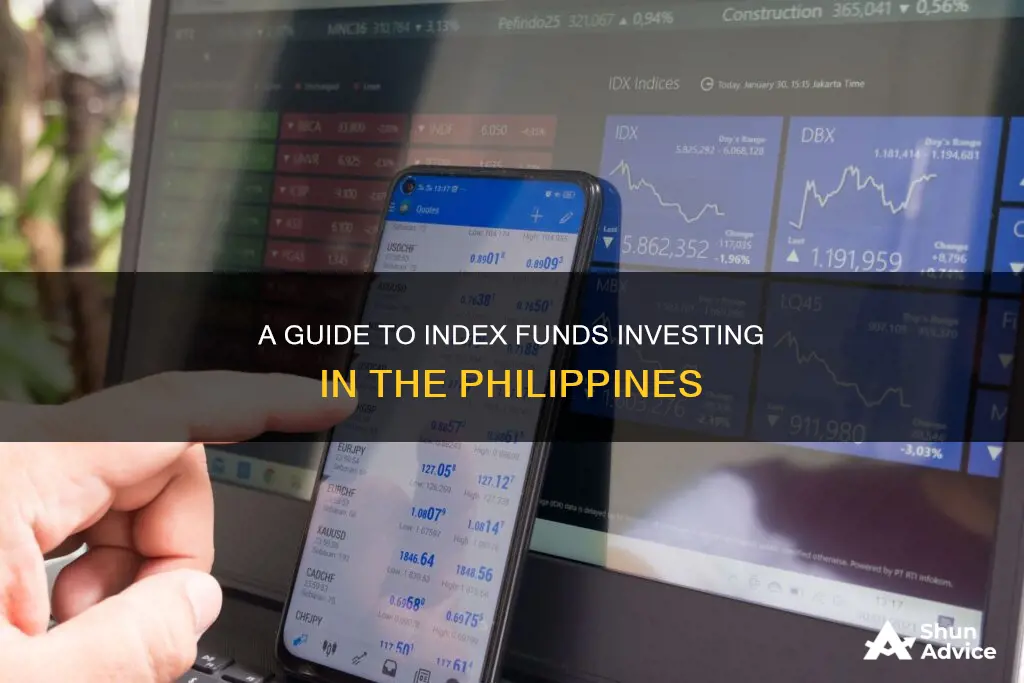
Index funds are a low-cost, efficient way of investing in the stock market. They are a type of fund that tracks the performance and returns of a particular market or industry index, such as the Philippine Stock Exchange Index (PSEi). The PSEi is made up of the top 30 publicly traded companies in the Philippines, also known as blue-chip companies.
Index funds are managed in a way that mirrors the stock index. They do this by buying shares in all 30 companies that make up the index and by buying them according to their weight in the index. This means that larger companies, such as SM, Ayala, and BDO, have a greater impact on the index's performance.
There are several benefits to investing in index funds, including:
- Instant broad diversification
- Lower costs compared to buying stocks individually
- Low expense ratios
- A wide variety of funds to choose from
- Low entry capital requirements
- Passive investing
There are several types of index funds available in the Philippines, including:
- Mutual funds
- Unit investment trust funds (UITF)
- Exchange-traded funds (ETF)
- Personal Equity and Retirement Account (PERA)
When investing in index funds in the Philippines, it is important to consider the fees and charges, do your due diligence, and choose a convenient platform.
| Characteristics | Values |
|---|---|
| Risk Tolerance | Moderate to High |
| Investment Horizon | Long-term |
| Minimum Initial Investment Amount | PHP 1,000 |
| Minimum Additional Investment Amount | PHP 1,000 |
| Management Fees | 0.50% to 2.15% |
| Tracking Error | 0.0003% to 3.03% |
| Type of Index Fund | Exchange Traded Fund (ETF), Unit Investment Trust Fund (UITF), Mutual Fund, Personal Equity and Retirement Account (PERA) |
What You'll Learn

How to choose the best index fund for you
Index funds are a great way to invest in the stock market, especially for beginners. They are a low-cost, efficient way of investing in the stock index, which is composed of the top 30 companies in the Philippines whose shares are traded in the Philippine Stock Exchange (PSE). These companies are also called blue chip companies, and you may know some of them, such as PLDT, Meralco, and Aboitiz Power.
When choosing the best index fund for you, here are some factors to consider:
- Fees and charges: Index funds have lower fees compared to actively managed funds, but it is still important to consider the impact of these fees on your return on investment (ROI). Compare the fees of different index funds and choose the one with the lowest fees, as this will give you higher returns in the long run.
- Convenience: Choose an index fund that is convenient for you to invest in. Consider factors such as the minimum initial investment amount, the ease of buying shares, and the accessibility of information and customer service.
- Tracking error: This is the gap between the returns of the index fund and the returns of the index it is tracking. A lower tracking error means that the index fund is able to replicate the performance of the index more accurately. While index funds with lower tracking errors are generally considered better, it is also important to consider other factors such as fees and convenience.
- Investment horizon: Index funds are typically suitable for long-term investing. If you are planning to invest for the long term, look for index funds with a long-term investment horizon.
- Risk tolerance: Index funds are considered less risky compared to investing in individual stocks, but they still carry some risk. Consider your risk tolerance and choose an index fund that aligns with your comfort level.
- Diversification: Index funds provide instant diversification by investing in a mix of domestic stocks or the top 30 companies in the PSE. This lowers the risk compared to investing in individual stocks.
- Performance: While past performance does not guarantee future results, it is still worth considering the historical performance of the index fund. Look for index funds with a solid track record of returns.
By considering these factors, you can choose the best index fund that aligns with your investment goals, risk tolerance, and financial situation. Remember to do your research and compare different index funds before making a decision.
Emergency Fund Strategies: Where to Invest for Peace of Mind
You may want to see also

Benefits of investing in index funds
Index funds are a popular investment choice in the Philippines, and for good reason. Here are some of the key benefits of investing in index funds:
Broad Diversification
The most significant advantage of investing in index funds is achieving instant diversification, reducing the risk of losing money. Index funds typically track a specific market index, such as the S&P 500, and hold a diverse range of stocks or other securities. By investing in an index fund, you gain exposure to a basket of carefully selected companies or assets, minimising the impact of any single investment on your portfolio's performance.
Low Costs
Index funds are known for their low costs, including management fees and taxes. The passive nature of index funds, which aim to mirror a specific index, results in lower management fees compared to actively managed funds. The expense ratios of index funds are typically lower, ranging from 0.05% to 0.07%, and some funds even have expense ratios as low as 0%. This means you keep more of your investment gains.
Attractive Returns
Index funds have a strong track record of generating attractive returns over time. Historical data shows that index funds often outperform actively managed funds, even those managed by top investment firms. The broad diversification and low costs of index funds contribute to their ability to deliver competitive returns.
Passive Income
Index funds offer a passive investment strategy. They are managed by fund managers, so you don't need to be an expert in stock trading to participate. You can enjoy the potential earnings of a well-diversified portfolio without the same level of active involvement required in other investment strategies.
Long-Term Results
Index funds are designed for long-term investing, and their performance over time is impressive. The stock index, which index funds mirror, has proven hard to beat in the long run. Even renowned investors like Warren Buffett recommend index funds for ordinary investors seeking strong, consistent returns.
IRA and Mutual Funds: A Smart Investment Strategy
You may want to see also

Index funds vs. equities funds
Index funds and equity funds are both investment options for those looking to enter the Philippine stock market. Here is a comparison of the two:
Index Funds
Index funds are a type of investment fund that tracks the performance of a market index, such as the Philippine Stock Exchange Index (PSEi). They are designed to mirror the performance of the index by holding a representative sample of the same stocks or bonds. Index funds are passively managed, meaning they aim to replicate the performance of the index rather than outperform it. This results in lower fees and expenses compared to actively managed funds.
Index funds are ideal for investors who want a simple, cost-effective, and diversified way to invest in the stock market. They are also suitable for those who may not have the time or expertise to actively pick and choose stocks.
Equity Funds
Equity funds, also known as mutual funds, are pooled investments that are actively managed by fund management professionals. They invest in a portfolio of stocks issued by individual companies, and the performance of the fund depends on the performance of the stocks in the portfolio.
Equity funds tend to have higher expense ratios than index funds because they require constant monitoring and optimisation of the portfolio by the fund manager, which involves various costs such as brokerage, exchange fees, and taxes.
Equity funds are suitable for investors who are willing to take on more risk and have the time and expertise to research and analyse individual companies.
Both index funds and equity funds have their advantages and disadvantages. Index funds offer a simple, low-cost, and diversified investment option, while equity funds provide the potential for higher returns but with higher fees and more risk. The choice between the two depends on the investor's financial goals, risk tolerance, and level of involvement in the investment process.
A Guide to Investing in the Baillie Gifford American Fund
You may want to see also

How to invest in index funds in the Philippines
Index funds are a low-cost, efficient way of investing in the stock market. They are a type of fund that is structured to track the performance and returns of a particular market or industry index.
There are several types of index funds available in the Philippines, including:
- Exchange-Traded Funds (ETFs)
- Mutual Funds
- Unit Investment Trust Funds (UITFs)
- Personal Equity and Retirement Accounts (PERA)
Each of these types of index funds has its own advantages and disadvantages, so it is important to do your research before investing. Some factors to consider when choosing an index fund include the fees and charges, the convenience of the platform, and the tracking error.
ETFs
ETFs are traded on the stock exchange, so you will need to open a brokerage account to invest in them. Here are the steps to invest in the First Metro Philippine Equity Exchange Traded Fund (FMETF), the only ETF available in the Philippines:
- Visit the First Metro Securities website and click "Open an account".
- Complete the online registration.
- Speak with a live agent for verification.
- Wait for the email confirmation advising your account is active and ready to trade.
Mutual Funds
Mutual funds pool money from investors and are managed by a professional fund manager. Here are the steps to invest in a mutual fund:
- Go to the mutual fund company's website and click on the MF registration page.
- Answer a few questions to determine your risk profile.
- Download and submit the required forms and documents.
- Fund your account once you receive confirmation.
UITFs
UITFs are similar to mutual funds but are offered and managed by banks. Here are the steps to invest in a UITF:
- Visit your bank of choice for your UITF account.
- Complete their Client Suitability Assessment form.
- Submit all requirements and receive a certificate of participation.
- Fund your account once it is active.
PERA
PERA is a voluntary investment program that offers tax benefits for retirement savings. Here are the steps to invest in a PERA account:
- Visit your administrator of choice (BDO or BPI).
- Complete all required documents and provide any necessary information.
- Wait for your PERA account to be activated and follow the instructions for funding, withdrawing, and accessing your account.
Vanguard Mutual Funds: Are They Worth the Investment?
You may want to see also

Tips for choosing the best index funds
- Decide on the type of index fund you want to invest in: Each option has its pros and cons, so weigh them according to your investment preferences and strategies. If you already have investments in mutual funds, for example, you might want to consider UITFs or ETFs and leverage their advantages.
- Consider fees and charges: How much you pay for fees can significantly impact your overall investment gains or losses. Even a difference of 1% or 2% between two index funds could spell the difference between hundreds and thousands of pesos in gains or losses, especially over time. Study the prospectus of the funds and check for any third-party fees not disclosed in their brochures. In general, choosing index funds with the lowest overall fees will give you a leg up over those with higher charges.
- Do your due diligence: Before investing, consider the "foundation" (index) that the fund is based on. There are several index funds to choose from, and each one will post relatively different performances even if they track the same index. "Tracking error" refers to how much of a difference there is between the return of the index fund and the stock index. In general, you'd want an index fund that can closely mirror the ROI of the stock index.
- Convenience is a factor: Pick a platform that will make things as easy as possible for you, from checking your investments to funding them, making trades, and general access.
Mutual Fund Investment Guide for NRIs in India
You may want to see also
Frequently asked questions
An index fund is a type of fund that's structured to track the performance and returns of a particular market or industry index. Mutual funds, Exchange-Traded Funds, and UITFs can all be classified as index funds.
The first index fund was created in 1975 by Jack Bogle, the founder and CEO of The Vanguard Group. His invention was a way for investors to mimic a particular market's performance but at a much lower cost than what mutual funds charge.
In the Philippines, these are the available companies that offer index funds:
- Unit investment trust funds (UITF)
- First Metro Philippine Equity Exchange-Traded Fund (FMETF)
- Variable universal life (VUL) plan
There are many advantages to investing in index funds, including:
- Instant broad diversification
- Low initial capital
- Passive income
- Long-term results
- Low management fees
- Diversification
Here are the steps to start investing in index funds in the Philippines:
- Compare fees and choose the fund with the least charges.
- Decide on a bank or trust entity and prepare the initial capital, a valid ID, and TIN.
- Drop by the bank or trust company and fill out the forms.
- Look out for a notification via text, email, or mail.







